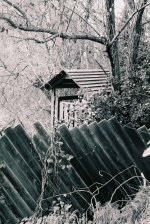like2fiddle said:
While we're on c41 vs. silver b/w... I remember reading somewhere here on RFF that the kodak C41 bw negatives could not be acurately printed with an enlarger, but that perhaps the Fuji XP 2 could? If this is so, one could use XP2 (assuming one likes the results), have the film developed and scanned at the one-hour lab, take the negs and print what you want on an enlarger?
Here's the deal: Kodak's BW400CN, like its color-neg counterparts, has an orange mask (which is why it's sometimes hard to differentiate BW400 from, say, Portra, when looking at the developed film with the naked eye), whereas Ilford's XP2 Super, the other C41 chromogenic, has no such mask.
The advantage of the orange mask is that it makes life a bit easier for lab operators to get a fix on making neutral (or at least
close to neutral) machine prints, which has been a bit more of a prolblem for people getting their XP2 rolls developed and printed at a minilab. The downside – and it's something of a biggie for some people – is that BW400 is a bear to work with in the conventional b/w darkroom when trying to make prints, whereas XP2 is a breeze to wet-print by comparison (you do need to crank up the contrast somewhat, compared to conventional b/w film, but that's about the only adjustment). Both films are drop-dead simple to scan, and if your scanner has Digital ICE, you can kiss the tedium of post-scan spotting good-bye (for the most part, anyway...every once in a while I need to do additional touching-up, but it's minimal at worst).
I use a lot of XP2 in my work (buying the occasional pack of BW400 if my supply of the former runs out at a bad time), but I also shoot, and process, the regular stuff as well (mostly HP5, and one or two slower emulsions i happen to have around). It's not an either/or thing with me – both have their virtues, and I wouldn't want to be without either.
- Barrett



